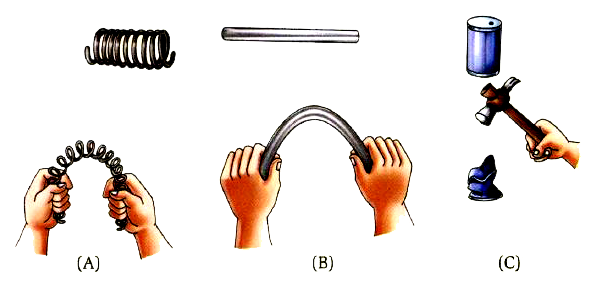What is the effect of force on non-rigid body?
Step-by-Step Solution
1. Understanding Non-Rigid Bodies:
- A non-rigid body is one that can change its shape when a force is applied. This is different from a rigid body, which maintains its shape regardless of the forces acting on it.
2. Applying Force:
- When a force F is applied to a non-rigid body, it causes a deformation in the shape of the body. This deformation can be visualized as a change from its original shape to a new shape (represented by a dotted line in diagrams).
3. Change in Shape:
- The first effect of applying a force on a non-rigid body is the change in shape. This means that the body will not remain in its original form but will instead deform according to the magnitude and direction of the applied force.
4. Change in State of Motion:
- The second effect is the change in the state of motion of the body. According to Newton's second law, when a force is applied to a mass, it causes acceleration.
- If the body was initially at rest, it will start to move. If it was already in motion with an initial velocity u, the application of force will change its velocity to v due to acceleration a.
5. Conclusion:
- Therefore, the two primary effects of force on a non-rigid body are:
1. Change in shape.
2. Change in state of motion (acceleration).
- A non-rigid body is one that can change its shape when a force is applied. This is different from a rigid body, which maintains its shape regardless of the forces acting on it.
- When a force F is applied to a non-rigid body, it causes a deformation in the shape of the body. This deformation can be visualized as a change from its original shape to a new shape (represented by a dotted line in diagrams).
- The first effect of applying a force on a non-rigid body is the change in shape. This means that the body will not remain in its original form but will instead deform according to the magnitude and direction of the applied force.
- The second effect is the change in the state of motion of the body. According to Newton's second law, when a force is applied to a mass, it causes acceleration.
- If the body was initially at rest, it will start to move. If it was already in motion with an initial velocity u, the application of force will change its velocity to v due to acceleration a.
- Therefore, the two primary effects of force on a non-rigid body are:
1. Change in shape.
2. Change in state of motion (acceleration).
Topper's Solved these Questions
- BOOK - ICSECHAPTER - LAWS OF MOTIONEXERCISE - TOPIC 1 (3 Marks Questions )4videos
LAWS OF MOTION
- BOOK - ICSECHAPTER - LAWS OF MOTIONEXERCISE - TOPIC 1 (4 Marks Questions )1videos
LAWS OF MOTION
- BOOK - ICSECHAPTER - ICSE ANNUAL EXAMINATION -2020EXERCISE - SECTION-II45videos
ICSE ANNUAL EXAMINATION -2020
- BOOK - ICSECHAPTER - LIGHTEXERCISE - TOPIC 2 Spherical Mirrors (4 Marks Questions )9videos
LIGHT
Similar Questions
What is the effect of force on a rigid body ?
View SolutionGive any two effects of a force on a non-rigid body.
View SolutionWhich of the following is not an effect of force on an object?
View SolutionIn the following pictures , figure out what are the effects of the forces on different objects.
 View Solution
View SolutionWhat is a rigid body?
View SolutionState the effects of a force applied on (i) a non rigid, and (ii) a rigid body. How does the effect of the force differ in the two cases ?
View SolutionS1: Net torque on a system due to all internal force about any point is zero.
S2: For rigid body undergoing fixed axis rotation, the direction of its angular acceleration and angular velocity
S3: if net torque on a rigid body about its centre of mass is zero, the angular speed of the rigid body is always zero.
S4: For a rigid body undergoing fixed axis rotation abouts its centre of mass, then net torque on rigid body about any point is same.View SolutionS1: If the internal forces within a system are conservative, then the work done by the external forces on the system is equal to the change in mechanical energy of the system.
S2: The potential energy of a particle moving along x− axis in a conservative force field is U=2x2−5x+1 is S.I. units. No other forces are acting on it. It has a stable equalibrium position at one point on x− axis.
S3:Internal forces can perform net work on a rigid body.
S4: Internal forces can perform net work on a non− rigid body.View SolutionWhat is the effect on the acceleration of a particle if the net force on the particle is doubled?
View SolutionPoint C is the centre of mass of the rigid body shown in figure. Find the total torque acting on the body about point C.
 View Solution
View Solution

